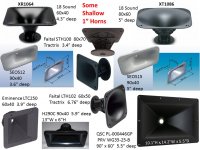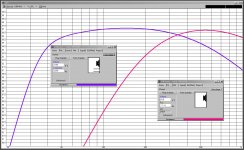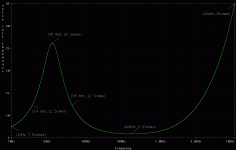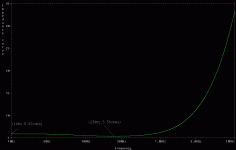Hi guys,
I'm going to build a 3 way speakers mostly for rock and electronic music.
I'm searching for the "punch" in the chest, and a good overall quality.
My fun room is about 340 sq. feet.
I live in Italy and have access to Faital Pro drivers... After an intensive search on the forum I selected those combinations:
N.1 (lower budget)
15PR400 woofer
M5N8-80 midrange
HF100 compression driver
STH100 horn
N.2 (higher budget)
18FH500 woofer
10PR410 midrange
HF10AK compression driver
STH-100 horn
all in the same cabinet, Woofers in ported chamber, CD and midrange in sealed chamber.
Both solutions amplified with Marani Plate amp with DSP
PDA530P - PDA Series - Marani Pro Audio
what solution will you chose for the best results in terms of sound quality, dynamics, and phisycal impact?
Will appreciate your suggestions about any driver swap, and moreover about crossover settings...
Thank you so much!
I'm going to build a 3 way speakers mostly for rock and electronic music.
I'm searching for the "punch" in the chest, and a good overall quality.
My fun room is about 340 sq. feet.
I live in Italy and have access to Faital Pro drivers... After an intensive search on the forum I selected those combinations:
N.1 (lower budget)
15PR400 woofer
M5N8-80 midrange
HF100 compression driver
STH100 horn
N.2 (higher budget)
18FH500 woofer
10PR410 midrange
HF10AK compression driver
STH-100 horn
all in the same cabinet, Woofers in ported chamber, CD and midrange in sealed chamber.
Both solutions amplified with Marani Plate amp with DSP
PDA530P - PDA Series - Marani Pro Audio
what solution will you chose for the best results in terms of sound quality, dynamics, and phisycal impact?
Will appreciate your suggestions about any driver swap, and moreover about crossover settings...
Thank you so much!
I would cross the woofer and mid between 200-300hz, the mid to compression driver between 1.5khz and 2khz. I would personally use the Harsch crossover topology if you can figure out how to implement it.
24db low pass on woofer.
12db bandpass on the mid.
24db highpass on the horn.
Measurement software such as Arta, HolmImpulse, and REW will help you with delay and eq settings.
24db low pass on woofer.
12db bandpass on the mid.
24db highpass on the horn.
Measurement software such as Arta, HolmImpulse, and REW will help you with delay and eq settings.
The xover point between mid and HF should be where their dispersion matches.
For the M5N8 that would be around 2.5kHz and for the 10PR410 around 1.4kHz.
The horn is pretty much at its limit there so I would use another larger horn with the dispersion you want or if you want to stay with Faital use the LTH102.
However dispersion is only 60x60 so cross around 1.7k.
Woofer to mid try 250-300Hz for the 15+5 and 150-200 for the 18+10 variant.
As for slopes unless you stumble across a good reason to use something else I'd start with 24dB Linkwitz-Riley.
Since you use DSP it is easy to experiment so those would be my starting points.
Seems like a fun project!
For the M5N8 that would be around 2.5kHz and for the 10PR410 around 1.4kHz.
The horn is pretty much at its limit there so I would use another larger horn with the dispersion you want or if you want to stay with Faital use the LTH102.
However dispersion is only 60x60 so cross around 1.7k.
Woofer to mid try 250-300Hz for the 15+5 and 150-200 for the 18+10 variant.
As for slopes unless you stumble across a good reason to use something else I'd start with 24dB Linkwitz-Riley.
Since you use DSP it is easy to experiment so those would be my starting points.
Seems like a fun project!
I'm going to build a 3 way speakers mostly for rock and electronic music.
I'm searching for the "punch" in the chest, and a good overall quality.
Both solutions amplified with Marani Plate amp with DSP
what solution will you chose for the best results in terms of sound quality, dynamics, and phisycal impact?
The 10PR410 is often recommended for quality midbass performance, impact, and dynamics.
====
18FH500 woofer - with Fs=30Hz and Qts=0.35 is well suited for ported bass
10PR410 midrange - with Aluminum demodulation ring for low Le, light 33g Mms, and "controlled" Qts=0.21 is an excellent sealed box midbass
HF10AK or newer HF108 compression drivers use a plastic diaphragm for smooth, extended HF response.
l own the HF108 and use it with the PRV WG35-25-B waveguide. Excellent.
Faital LTH102 horn with a crossover around 1400-1500Hz should pattern match well with the 10" midbass
--you should test (floorplan sketch) the 60H x 50V polar pattern to see if it matches your room and seating position.
For the best soundstage, the DSP will need to create a time delay match between the LTH102 and 10PR410
======
The STH-100 horn seems too small to accurately control the optimum 1400Hz crossover desired for a 10" midbass. You could cross at 1500-1600Hz with this shorter horn, but might hear some 10PR410 cone effects starting a 2kHz.
The 80H x 70V polar response is wide enough to cover a small multi-seat listening area (floorplan sketch), but will also bounce some sound off the walls in a narrow/small room.
More advice on the STH-100 horn will help you final decision.
Attachments
FaitalPRO | Coaxial Loudspeakers | 10HX230
..this one is brand new, so it might be a bit before it's available for purchase.
and 2 of these per speaker wired in parallel to 8 ohms:
FaitalPRO | LF Loudspeakers | 12FH500
..large cabinet, low port tuning freq.. (as a guess: around 21 Hz or so.) Vent forward (front baffle) and next to the floor, rectangular preferred.
..this one is brand new, so it might be a bit before it's available for purchase.
and 2 of these per speaker wired in parallel to 8 ohms:
FaitalPRO | LF Loudspeakers | 12FH500
..large cabinet, low port tuning freq.. (as a guess: around 21 Hz or so.) Vent forward (front baffle) and next to the floor, rectangular preferred.
Last edited:
WinISD plots of:
-ported 8cuft 18FH500. Good performance even with 6cuft.
---You should get ~95db efficiency after baffle step compensation.
-sealed 10PR410. Similar SPL/watt to woofer in sealed 0.15-0.2 cuft volume
Marani Plate amp with DSP specs show wide range of crossover slopes, plus good(20ms) delay adjustments.
-ported 8cuft 18FH500. Good performance even with 6cuft.
---You should get ~95db efficiency after baffle step compensation.
-sealed 10PR410. Similar SPL/watt to woofer in sealed 0.15-0.2 cuft volume
Marani Plate amp with DSP specs show wide range of crossover slopes, plus good(20ms) delay adjustments.
Attachments
Last edited:
thank you so much guys for the suggestions and the filter settings.
Do you think that such a speaker can give me a "semi-PA" dynamic and that midbass punch I'm looking for?
I'm so tired about hifi speakers...
Do you think that such a speaker can give me a "semi-PA" dynamic and that midbass punch I'm looking for?
I'm so tired about hifi speakers...
thank you so much guys for the suggestions and the filter settings.
Do you think that such a speaker can give me a "semi-PA" dynamic and that midbass punch I'm looking for?
I'm so tired about hifi speakers...
Such a speaker will blow you away the 10ak is a mighty fine driver! Sweet, smooth and extended!
You can try both ways but make the horn close to ear level.
This rig has potential for all the impact and detail you can ask for. You'll have to make sure you can get a smooth response at the listening position. Cancellations and peaks in the bass and lower midrange can really degrade sound quality.
I've been running 2x18's and a 12" coaxial per side for a few years now. Still brings a smile everytime I get a chance to sit in front of it. This is for a large garage though, I would down size a bit in a house.
This rig has potential for all the impact and detail you can ask for. You'll have to make sure you can get a smooth response at the listening position. Cancellations and peaks in the bass and lower midrange can really degrade sound quality.
I've been running 2x18's and a 12" coaxial per side for a few years now. Still brings a smile everytime I get a chance to sit in front of it. This is for a large garage though, I would down size a bit in a house.
thank you so much guys for the suggestions and the filter settings.
Do you think that such a speaker can give me a "semi-PA" dynamic and that midbass punch I'm looking for?
I'm so tired about hifi speakers...
Yes, with a lower Qes driver and a large volume and low tuning freq bass reflex design. ALSO use an Impedance filter on the resonance in-box to flatten the driver's impedance.
Also use a very dense baffle material (cement/metal/etc.) and use a plinth with spikes on the top and bottom (..bottom to floor and top to speaker). Again, with the vent(s) near the floor, rectangular, and exiting the front baffle.
Since he is running them active is there much advantage to flattening driver's impedance?
ABSOLUTELY!
This isn't about crossover integration, but rather how the amp reacts with current to the driver under dynamic conditions near resonance.
-one of the nicer things here is that you don't need expensive components, just components with low resistance.
Last edited:
Do Class D amps have issues with high impedances that make that more beneficial than a direct coupling of driver to amp?
I've never had problems with my amps but they are class AB and essentially don't care if the work into 1Ω or 1kΩ. Not needing any impedance flattening is often cited as an advantage of active operation unless one uses valve amps.
So what are those advantages and what are the problems?
I've never had problems with my amps but they are class AB and essentially don't care if the work into 1Ω or 1kΩ. Not needing any impedance flattening is often cited as an advantage of active operation unless one uses valve amps.
So what are those advantages and what are the problems?
You never really hear it as a problem until you make that change.. and then it's like: "wow, I've got a half octave or more of extension - with a "tighter" "cleaner" bass presentation".
However if your amp can work lower ohm loads, the less difference it makes (..and usually the larger the power supply is).
Class D amps almost always have some problem with this and are almost never 1 ohm load stable under normal operation.
However if your amp can work lower ohm loads, the less difference it makes (..and usually the larger the power supply is).
Class D amps almost always have some problem with this and are almost never 1 ohm load stable under normal operation.
Last edited:
I would suggest using 8PR155 as midrange also from Faital Pro. HF10AK behind a STH-100 works flawlessly. I would say it's the best horn tweeter under 500bucks. Volti Audio uses HF10AK with an elliptic flare horn called XT-120 from 18Sound in all this speakers but to my ear Faital Pro STH-100 is a better-sounding match when the horn back side is dampened using some bitumen or epoxy foam
Do you think 250w/8ohm - 500w/4ohm (Pascal D module on Marani plate amp) will be enough to drive the 18 inch woofer?
PDA530P - PDA Series - Marani Pro Audio
PDA530P - PDA Series - Marani Pro Audio
Cheers Scott!
Starting to make sense now but luckily my amps have rather over-engineered PSUs and quite happy to run nominal 2Ω loads at full power.
On a side note and for future projects could I avoid these probs when using class AB chip amps (like LM3886) by increasing PSU capacity above the minimum recommendation?
Starting to make sense now but luckily my amps have rather over-engineered PSUs and quite happy to run nominal 2Ω loads at full power.
On a side note and for future projects could I avoid these probs when using class AB chip amps (like LM3886) by increasing PSU capacity above the minimum recommendation?
- Status
- Not open for further replies.
- Home
- Loudspeakers
- Multi-Way
- New 3 way with Faital Pro drivers: suggestions



